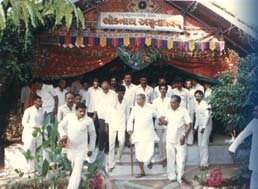Loknath Amrutalayam ( Eternal Abode of the Lord of the world )
To restore the temples to their original role as socio-economic centers of the village, Swadhyay has taken a new initiative of non-sectarian temple-building called Loknath Amrutalayam. Built from locally available material and with voluntary labour of the swadhyayees, Amrutalayams are simple, semi-permanent structures without walls, but mostly with gardens around them.

Each village couple, irrespective of caste origin, gets a chance to work
as priest (pujari) for a few days in the year. Villagers gather in Amrutalayam
every morning and evening for prayers. A Hindu can recite the Geeta with the
same freedom as Moslem the Koran or Christian, the Bible. After the evening
community prayer, the assembly discusses individual and collective problems
and attempts to sort them out informally. It reviews the progress of Swadhyay
activities running in the village. At regular intervals the swadhyayee villagers
offer to God a portion of their earnings; they do so anonymously and voluntarily.
The collections so received are distributed to the needy as benediction (prasad)
of God , and the surplus is spent on infrastructural needs of the village as
a whole.
More than a place for remembering God, Amrutalayam becomes focus of an alternative
world of learning and culture, of personal and social renewal, and of community
life independent of the state institutions and processes. These are centers
where grievances and social problems are sorted out in the spirit of give and
take, spirit of mutual help is reinforced, and initiatives are taken for innovations
and reforms. Swadhyay projects an outlook that is sought to be internalised
at all levels and Amrutalayam is one of the facilitating institutions of Swadhyay.
The first Amrutalayam was built in 1980. Such villages where ninety per cent
people are committed swadhyayees are allowed to build them. There are now about
150 of them and an equal number of villages have graduated to that stage.